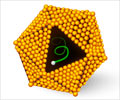The answer to a 40-year-long puzzle about a mysterious process by which a critical enzyme metabolizes drugs and chemicals in food has been found by Penn State University researchers.

The find may help development of a wide range of more efficient and less-expensive drugs, household products, and other chemicals.
Enzymes in the family named P450 pass through a critical chemical phase-change called "Compound I," whereby an oxygen molecule is temporarily added.
"This phase change happens quickly, and P450 just as quickly changes back to its original state," Green explained.
Green and his colleagues grew one of the P450 enzymes in E.coli -bacteria found in the human gut. They then developed a method to cool the enzyme at just the right rate-one one-thousandth of a second -- to "freeze in time" the formation process of Compound I.
Green also explained that different populations of humans vary in which version of the gene they carry, and thus, which version of P450 they produce.
Advertisement
"The answer to why some people have bad interactions could be understood at the level of the P450 enzymes and their state changes. Now that we can see those state changes on a molecular level, a deeper investigation is finally possible."
Source-ANI














